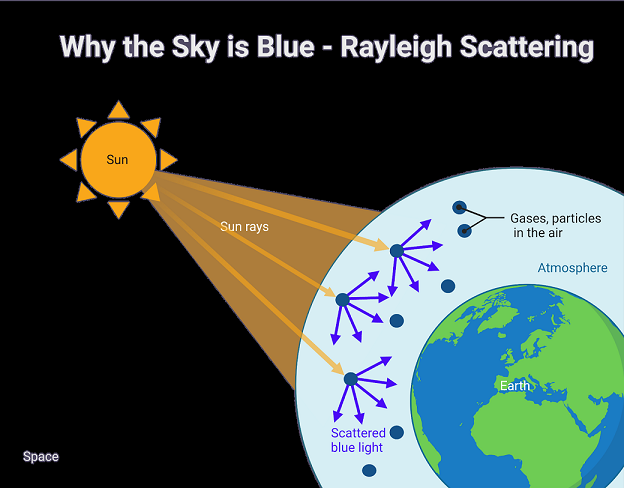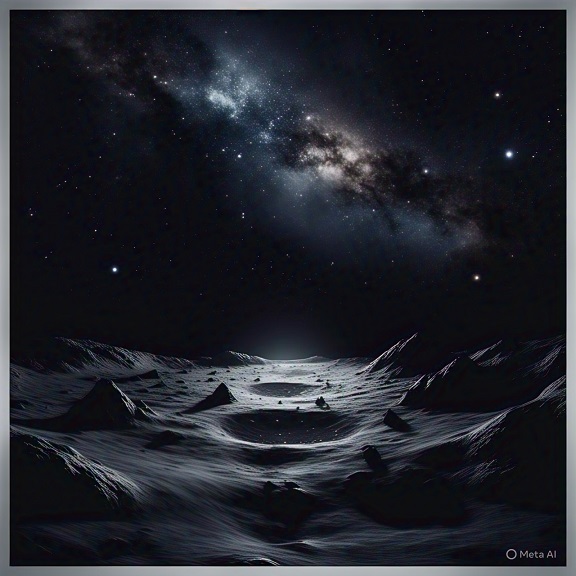Have you ever gazed up at the sky on a clear day and wondered, Why is the sky blue? It’s one of those simple yet fascinating questions that many of us have asked since childhood. The answer lies in the way sunlight interacts with Earth’s atmosphere, and today, we’ll dive into the science behind this everyday wonder.
Table of Contents
The Basics: Sunlight and the Atmosphere
To understand why the sky appears blue, we first need to look at sunlight. Sunlight may seem white, but it’s actually a mix of different colors—each with its own wavelength. When sunlight reaches Earth, it passes through our atmosphere, which is made up of tiny molecules, primarily nitrogen and oxygen.
This is where the magic happens.
Rayleigh Scattering: The Key to the Blue Sky
The phenomenon responsible for the blue sky is called Rayleigh scattering. Named after the 19th-century British scientist Lord Rayleigh, this effect explains how light scatters when it interacts with particles much smaller than its wavelength.
Here’s how it works:
- Sunlight Enters the Atmosphere – As sunlight travels toward Earth, it encounters gas molecules.
- Shorter Wavelengths Scatter More – Blue light has a shorter wavelength (about 400-500 nanometers) compared to other colors like red or orange. Because of its short wavelength, blue light gets scattered in all directions by the gas molecules.
- Our Eyes See Blue Everywhere – When we look up, this scattered blue light reaches our eyes from all over the sky, making it appear blue.

Why is the Sky Blue but Not Violet?
If shorter wavelengths scatter more, why isn’t the sky violet, since violet light has an even shorter wavelength than blue? The answer lies in our eyes:
- Human eyes are more sensitive to blue than violet.
- Sunlight contains more blue light than violet.
- Some violet light gets absorbed by the upper atmosphere.
So, while violet does scatter, our brains perceive the dominant blue instead.
The Role of the Sun’s Position
Have you noticed that the sky doesn’t always look the same shade of blue? The color can change depending on the sun’s position:
- Midday Sky – When the sun is directly overhead, sunlight passes through less atmosphere, so blue appears vivid.
- Sunrise/Sunset – At these times, sunlight travels through more atmosphere, scattering the blue light away and leaving longer wavelengths (reds, oranges, and pinks) to dominate.
This is why sunsets often look red or golden—blue light has been scattered out of our line of sight.
What If Earth Had No Atmosphere?

Without an atmosphere, the sky wouldn’t be blue at all. Astronauts on the Moon see a black sky because there’s no air to scatter sunlight. Similarly, if Earth had a different atmospheric composition (like Mars, which has a thin CO₂-rich atmosphere), the sky might appear reddish or even another color entirely.
Common Myths About the Blue Sky
There are a few misconceptions about why the sky is blue. Let’s debunk them:
❌ Myth 1: The sky is blue because it reflects the ocean.
✅ Fact: The ocean appears blue because it reflects the sky, not the other way around.
❌ Myth 2: Blue light is the only color scattered.
✅ Fact: All colors scatter, but blue scatters much more due to its short wavelength.
❌ Myth 3: The sky is blue because of oxygen.
✅ Fact: While oxygen is part of the atmosphere, nitrogen plays a bigger role in scattering sunlight.
Fun Experiments to Try
Want to see Rayleigh scattering in action? Try these simple experiments:
🔹 Milk in Water – Add a few drops of milk to a glass of water and shine a flashlight through it. The liquid will appear slightly blue from the side, mimicking how sunlight scatters in the atmosphere.
🔹 Sunset in a Jar – Use a flashlight and a prism to split light into colors, then pass it through a smoky or dusty container. Observe how different wavelengths behave.
Final Thoughts
Next time someone asks, Why is the sky blue?, you’ll know the answer lies in the beautiful physics of light scattering. From the deep blue of a midday sky to the fiery hues of sunset, our atmosphere transforms sunlight into a daily spectacle.
So, take a moment to look up and appreciate the science behind nature’s most common yet mesmerizing wonder—the blue sky.
Do you want to read more about science. check this out: 1] What is Gravity? 2] Easy Science Experiments for Kids 3] What is Electricity? 4] What Causes Earthquakes?
